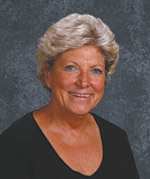April 30, 2014
Our Ever-Changing Weather
 By Mary Schricker Gemberling
By Mary Schricker Gemberling
Friday and Saturday of last week in 70+ degrees, I worked in the yard and garden, raking leaves and unearthing the first sprouts of spring. Today, as I write this article, the wind is howling and temperatures are struggling to stay in the 30s. The ever-changing weather, a sometimes frustrating and sometimes joyous phenomena, affects every aspect of our lives. It impacts our pocketbooks, our menus, our schedules, and even our health. The impact of severe weather is felt almost every day by tens of thousands of Americans. Damage from this winter’s cold wave in the U.S. alone was estimated at nearly $5 billion. Weather impacts all commercial activities. Estimates indicate that 30 percent of gross domestic product is directly or indirectly affected by weather.
Checking the daily weather forecast is part of a regular routine for many of us. Matter of fact, our smart phones let us check it multiple times throughout the day, allowing us to be prepared for any changes that might occur. Although the process was much more difficult than it is today, our forefathers have been predicting weather since the early American colonial days. The first systematic weather observations in North America were made in 1644 in Wilmington Delaware, by Reverend John Holms. Observations of storm movements and weather patterns were first noticed by Benjamin Franklin when he documented the movement of a hurricane from Philadelphia to Boston in 1743. During the signing of the Declaration of Independence Thomas Jefferson noted that the high temperature for Philadelphia on July 4, 1776, was 76 degrees Fahrenheit. Presidents such as George Washington and Jefferson were some of the first weather observers in the country. And, during their trip to explore the western U.S. in 1804-1806, the Lewis and Clark expedition made regular weather observations.
As weather examinations began to gain the attention of both leaders in government as well as the general population, Thomas Jefferson began to recruit volunteer weather observers throughout Virginia. By 1800, there were volunteers in five states including Massachusetts, Pennsylvania, Connecticut, New York, and North Carolina. In 1814, Surgeon General James Tilton, issued orders for conducting weather observations at Army posts across the country and the idea of a weather network was born. In 1848, 150 volunteers were enlisted to forecast storms using the newly operational telegraph. By 1860, 500 stations, manned by volunteers furnished daily telegraphic weather reports, and on February 9, 1870, President Ulysses S. Grant, signed a joint resolution of Congress authorizing the Secretary of War to establish a National Weather Service.
Over the years, the advancement of technology including the development of radar and satellites has greatly improved the reliability of weather forecasting. However, the National Weather Service still depends on volunteer support from the general public to gather weather observations through two major programs: Storm Spotters and the Cooperative Observer Program. More than 11,000 volunteers take observations on farms, in urban and suburban areas, at national parks, along seashores and on mountaintops. In addition, the more than 230,000 trained storm spotters help keep their local communities safer by sending the National Weather Service timely and accurate reports of severe weather.
A less scientific method of predicting the weather has been used by The Farmer’s Almanac for over 197 years. The forecasts are reportedly based on a secret mathematical and astronomical formula, including sunspot activity, lunar cycles and planetary position. The book claims to be right 80% of the time! If the Almanac is correct for the coming months stock up on suntan lotion and make sure those air conditioners are in working order. The forecast: summer will be much hotter than normal, with near-normal rainfall! Doesn’t sound so bad as I gaze wistfully out my window??
“Whether the weather be fine; whether the weather be not; whether the weather be cold; whether the weather be hot; we’ll weather the weather, whatever the weather, whether we like it or not.” – Author unknown
Mary Schricker Gemberling
Mary, a former educator and Seniors Real Estate Specialist, is the author of two books, The West End Kid and Labor of Love; My Personal Journey Through the World of Caregiving.
Filed Under: History, Technology
Trackback URL: https://www.50pluslife.com/2014/04/30/our-ever-changing-weather/trackback/


